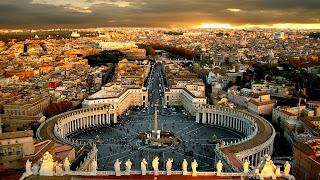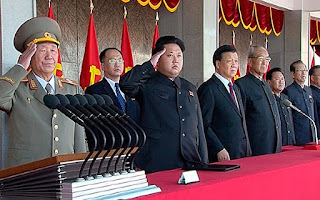Here's what you need to know about the Vatican—equally known as the Holy See.
Here's
what you need to know about the Vatican—equally known as the Holy See.
Vatican
Fast Facts:
The full name of the country is the State of Vatican
City, and it is the spiritual and governing center of the Roman Catholic
Church.
It stands on Vatican Hill in northwestern Rome, Italy
west of the Tiber River.
Tall stone walls surround most of Vatican City.
Historical documentation reveals that St. Peter was
crucified at or near the Neronian Gardens on Vatican hill and buried at the
foot of the hill directly under where the main altar of St. Peter's Basilica
now stands. Excavations at the basilica between 1940 and 1957 located the tomb
believed to be St. Peter's.
Vatican City has its own pharmacy, post office. It
operates its own telephone system, and media outlets.
The Vatican is an absolute monarchy. Full legislative, judicial
and executive authority resides with the pope.
St. Peter's Basilica:
It is the world's second-largest Christian church
after the Yamoussoukro Basilica in Cote D'Ivoire. St. Peter's is not a cathedral, which is a bishop's
principal church. The pope is the bishop of Rome, and his cathedral church is
in Rome.
Built on the foundation of the first St. Peter's, the
new basilica took 120 years to complete. Masonry, sculpture, painting and
mosaic work continued for nearly another 200 years.
The dome of the basilica was designed by
Michelangelo, and is 400 feet tall and 138 feet in diameter.
The church is shaped like a cross and is almost 700
feet long, 450 feet wide at its widest point, and stands on more than 18,000
square yards.
In the grottoes or necropolis, beneath the basilica,
is a papal burial chamber. The tombs of many popes, including St. Peter (the
first pope), are located here.
Vatican Palaces:
The Vatican Palaces consist of several connected
buildings with over 1,000 rooms. Within the palaces there are apartments,
chapels, museums, meeting rooms and government offices.
The Palace of Sixtus V is the Pope's residence.
The Vatican museums, archive, library, gardens and
other offices make up the remainder of the palaces.
The Sistine Chapel:
Interior
A separate structure from the basilica, designed to
be the pope's chapel, was commissioned by Pope Sixtus IV della Rovere.
The Sistine Chapel was designed by architect Giovanni
dei Dolci. The decorations by Pier Matteo d'Amelia, Michelangelo, Raphael and
others continued for 60 years after construction was completed.
It is the site of the papal conclave and where
elections for the new pope are held.
It is one of the world's most famous galleries of
biblical art with the ceiling by Michelangelo, tapestries by Raphael and
Rosselli's Last Supper.
Timeline:
320s - Construction begins on the
first St. Peter's, by order of Constantine the Great.
1473-1481 - The Sistine Chapel is
constructed.
April 18, 1506 - Pope Nicholas V
begins rebuilding and expanding St. Peter's Basilica.
1508-1512 - Michelangelo paints the
ceiling of the Sistine Chapel.
1919 – The first meeting ever
between a Pope and a United States President was in 1919—when President Woodrow
Wilson held an audience with Pope Benedict XV, after World War I.
February 11, 1929 - The signing of
the Lateran Pacts between the Holy See and Italy establishes the Vatican City
State, the smallest independent nation in the world, covering only 109 acres.
June 7, 1929 - The Treaty of the
Lateran is ratified. Pope Pius XI gives up all claims to the Papal States, and
Italy agrees to the establishment of the independent State of Vatican City.
1950 - Declared a Holy Year by Pope
Pius XII, is also the year an excavation for a subway in Rome leads to an archaeological find that extended to the floor beneath St.
Peter's Basilica.
October 11, 1962-November 21, 1964 -
The 21st Ecumenical Council of the Roman Catholic Church, known as Vatican II,
is held under orders of Pope John XXIII. The council included 2,700 clergymen
from all walks of Christiandom looking to improve relations with the Catholic
Church. By the end of the council there is a new pope, Paul VI, a new constitution for the Church and new reforms.
1979 – The first Pope to ever
visit the White House was Pope John Paul II in 1979, during the Presidency of
Jimmy Carter.
June 2011 - Pope
Benedict XVI sends the first Vatican tweet announcing the opening of the
news portal, "Dear Friends, I just launched News.va Praised be our Lord
Jesus Christ! With my prayers and blessings, Benedictus XVI."
May 23, 2012- October 6, 2012 -
Paolo Gabriele, butler to Pope
Benedict XVI, is arrested for illegal possession of confidential documents.
The documents are the hundreds of personal letters and confidential documents
that have been released to Italian journalist and author, Gianluigi Nuzzi.
Gabriele is tried, convicted and sentenced to 18 months in prison by a Vatican
court.
November 10, 2012 - Claudio
Sciarpelletti, a computer technician, receives a two-month suspended sentence
for leaking Vatican secrets to the media.
December 22, 2012 - Gabriele is pardoned
by the pope and immediately released to his family.
February, 2013 – Pope Benedict XVI became
the first Pontiff in 600 years to resign from office, instead of ruling for
life.
March, 2013 – Pope Francis is the
first Jesuit Priest to become Pope in the 481 year history of the religious
Order.
May 2013 - Missio, a smartphone app, is launched by Pope Francis. The
app provides Catholic news from the Vatican and around the world.
November 24, 2013 - The Vatican
exhibits the bones of a man long believed to be St. Peter, one of the founding
fathers of the Christian church, for the first time.
2014 - The Pontifical Council for
Social Communications launches The Pope App, to follow papal events and
Servizio Internet Vaticano - Direzione TLC launches Vatican.va, the official
app of the Holy See.
September
23rd, 2015 – Pope Francis became the first Pope to
visit the Oval Office of the US White House. Pope Francis and President Barack
Obama met in the grandeur of the Oval Office during the Pope’s visit to the
White House—in the grandest State visit ceremony since President Obama took
office.
Below is a link to the full address to Congress
September
24th, 2015 – Pope Francis became the first Pope
ever to address the Congress of the United States of America.
September
24th, 2015 – Pope Francis became the first Pope to
address the opening session of the United Nations General Assembly.















Comments
Post a Comment